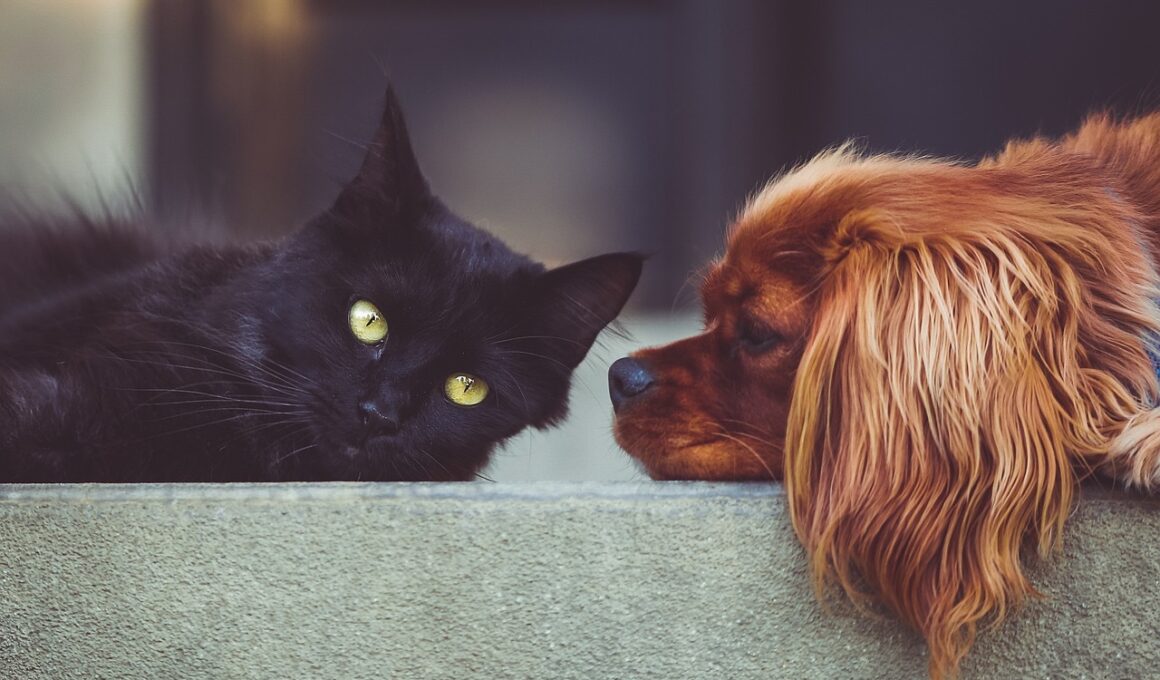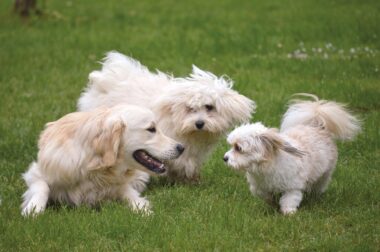Best Practices for Safe Interactions Between Dogs and Other Pets
Understanding how to socialize dogs with other pets is essential for fostering harmonious living environments. Proper socialization begins at a young age, ideally when dogs are puppies. Gradually introducing them to various animals can help them adapt better to multi-pet households. When introducing a new dog to the existing pets, do so slowly and carefully. This minimizes the chance of aggression or fear. Start by allowing them to sniff each other through a barrier like a baby gate. This provides a sense of security for both animals. If you notice any signs of stress, take a break. Owners should always supervise initial interactions, ensuring both pets feel calm. Pay attention to body language; signs of discomfort include growling, whimpering, or backing away. If the interaction goes well, reward both pets with treats and praise. Consistency is vital in reinforcing positive behavior. Training sessions that include all pets can also be beneficial in developing a stronger bond. Overall, patience and observation are key components for successful integration.
Once dogs and other pets have met safely and shown signs of comfort, positive reinforcement remains crucial. The practice of rewarding calm behavior encourages good habits during interactions. Use treats, praise, or playtime as motivators. Ensure that every interaction highlights positive reinforcement, which will help all pets associate each other with something enjoyable. Keep sessions brief during the early stages to avoid overwhelming any pet. Gradually increase the duration as they become more comfortable. Environmental factors can greatly influence these interactions. Choose a neutral space for initial meetings, away from each pet’s established territory. This helps reduce territorial aggression and allows each pet to feel secure. It’s also beneficial to engage in pre-play activities with each pet before they meet to expend excess energy. For dogs, a good walk or play session can help calm them. Manage introductions according to each pet’s temperament and personality. Some pets may need longer to adjust than others. Therefore, tailor your approach to each situation while still monitoring all interactions, ensuring everyone feels safe and secure throughout the experience.
Recognizing Stress Signals in Pets
Paying attention to stress signals in pets is crucial during their interactions. Dogs, cats, and other domesticated animals often exhibit body language indicating discomfort or fear. Common signs of stress include lowered ears, tucked tails, or dilated pupils. If a dog barks excessively or attempts to hide, it may indicate anxiety. Recognizing these behaviors is essential for ensuring the safety of all pets involved. When you observe such signals, provide a safe space where they can retreat if needed. Often, fostering calmness can help mitigate these negative emotions. Employ calming techniques, including soft music and natural calming aids, which can ease tension among pets. Techniques like these can be beneficial before interactions. Never force pets to interact if they display fear or signs of aggression. Socialization takes time and should be conducted at a comfortable pace for all involved. In addition, observe the interactions closely, ready to intervene if necessary, maintaining a positive atmosphere. Consistent observation and gentle corrections maintain a safe and friendly environment for all pets. This approach ultimately lays the foundation for enjoyable playtime in the future.
In addition to recognizing stress signals, understanding different animal temperaments can facilitate positive interactions. Each pet has its unique personality traits that dictate behavior during socialization. Some dogs may display overt friendliness, while others, particularly rescue or shy dogs, may be more reserved. Recognizing these traits plays a significant role in effective socialization. When introducing a timid pet to a boisterous one, proceed delicately. Allow the timid pet time to adjust while providing comfort through reassurance and treats. Likewise, consider the compatibility of pets by assessing their energy levels. High-energy dogs may overwhelm slower, more laid-back pets, causing stress. Keep in mind that different species have varying social cues. Make a deliberate effort to learn these cues, as this enhances interactions with pets such as cats, rabbits, or birds. For instance, a wagging tail may convey excitement in dogs but signifies agitation in cats. Establish rules to ensure the safety and well-being of all pets involved. Awareness of behavioral differences is key to cultivating a supportive environment, contributing to successful integration over time.
Structured Playtime and Training
Establishing structured playtime and incorporating training techniques strengthens bonds among pets. Play fosters social skills and provides an outlet for energy. Create designated play sessions with clear boundaries, allowing pets to engage and socialize under specific conditions. Use toys that are safe for all involved, allowing them to play together positively without aggression. Incorporate basic command learning into play sessions; this ensures all pets respond appropriately in social situations. Reinforce good behavior with treats and praise, which creates a positive learning environment. Keeping sessions interactive while incorporating training keeps pets engaged. Adjusting difficulty level based on their skill can sustain interest. Beyond just play, creating routines can improve overall interactions. Involving each pet in daily activities can foster community, further reinforcing a sense of belonging. Structure breeds comfort, which is especially important in multi-pet households. Ensure sessions are age-appropriate and tailored to individual needs, ensuring everyone remains stimulated and content. Remember that consistency is vital, and repeating structured activities fosters familiarity and promotes lasting relationships in the home environment.
It’s essential to socialize dogs and other pets throughout their lives, not just during the formative years. Regular interactions maintain learned behaviors and promote continuing relationships. Set regular playdates or join community pet groups to facilitate ongoing socialization. Consistency nurtures bonds and assures all pets feel secure in their roles. Engaging in shared activities such as group walks or training sessions can benefit all pets involved. Moreover, exposing pets to various environments and new experiences further enhances their adaptability. Take pets to parks, pet-friendly stores, or host pet-friendly gatherings at home. Each of these encounters helps reinforce confidence and encourages positive behavior in new contexts. Observing how they interact in these environments aids in learning about their individual responses to stimuli. When introducing new pets, adapt existing routines and incorporate new introductions carefully. The addition of new pets brings a fresh dynamic but may create challenges. Patience during transitions is vital. Be prepared to alter techniques based on group dynamics, behavior changes, or special needs for households with multiple pets. Establishing this adaptability fosters resilience for pets in shared living arrangements.
Long-Term Benefits of Socialization
When properly approached, socialization among pets leads to long-term benefits. Pets learn vital skills necessary for adjusting to diverse situations and environments. Socialized pets typically exhibit fewer behavior problems, such as aggression or anxiety, making interactions more enjoyable for their owners. Moreover, pets gain confidence from regular positive engagements, which encourages them to approach new experiences fearlessly. This confidence ensures companionship and reduces the likelihood of separation anxiety during instances when they must be left alone. Additionally, well-socialized pets are often healthier due to increased physical activity through regular play and exercise. Socialization promotes mental stimulation as pets learn to interact positively with one another. As they grow more comfortable and confident, owners also experience the benefits of having well-adjusted pets. Creating a friendly environment leads to a thriving household dynamic. Owners can relax and enjoy their pets’ companionship without constant worry. Consistent engagements among pets contribute to a happy home life. This fosters lifelong culture of support, friendship, and love within the household, ultimately creating the ideal living environment for everyone involved.
In conclusion, socializing dogs around other pets calls for commitment and patience from their owners. Following established best practices significantly enhances the likelihood of successful experiences. Observing body language, engaging in structured play, and allowing for gradual introductions lay the groundwork for safe interactions. Owners play a crucial role in ensuring pets remain to feel comfortable and secure. The long-term rewards of socialization highlight its importance in maintaining a peaceful, loving home. Educating oneself on animal behavior fosters a greater understanding and respect for each pet’s unique personality traits. Adapting strategies according to individual needs reinforces trust while ensuring safety and enjoyment in multi-pet households. Moreover, engaging with pets in various environments deepens their adaptability and confidence. This approach ensures a fulfilling and enriching life for all pets. Ultimately, owners are responsible for creating an environment that nurtures positive interactions. It’s essential to focus on quality time spent with each pet, further enhancing bonds. Emphasizing socialization brings satisfaction and happiness for both the pets and their owners, resulting in a loving, well-adjusted household.





